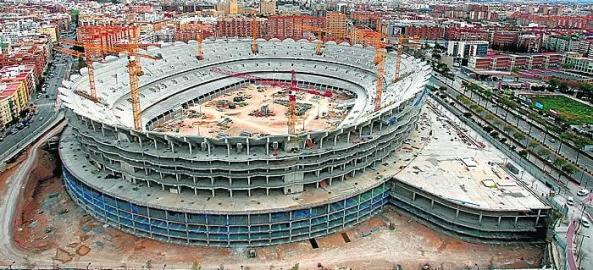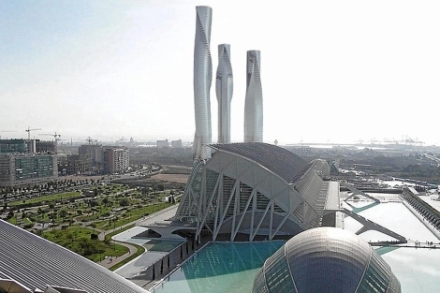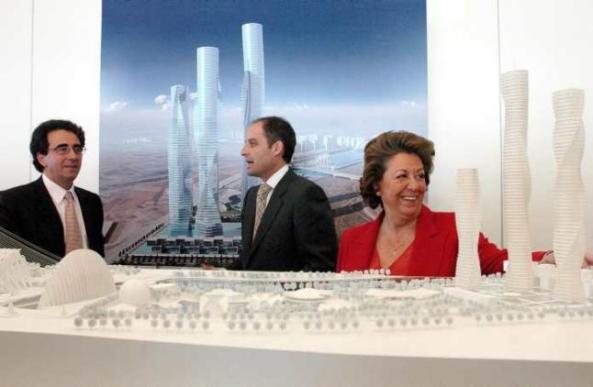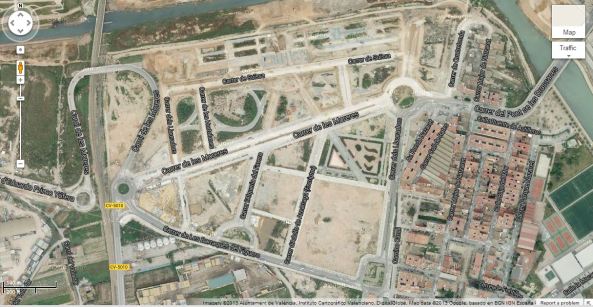The over-ambitious plan by Calatrava to place 3 skyscrapers next to Valencia´s Ciudad de las Artes y las Ciencias (CAC), The skyscrapers were never built but Calatrava received a handsome amount of public funding for a couple of paper models.
Esteemed cost of the complete project: 450 million €
Real cost: 15 million €
The Plan
In November 2004 Santiago Calatrava, accompanied by the president of the region Valencia Francisco Camps and by Valencian mayoress Rita Barberá, presented the plan of erecting 4 brand new sky-scrapers next to the Valencian Ciudad de las Artes y las Ciencias (CAC). The general impression was that by selling the four new Calatrava towers, the city of Valencia hoped to gain a little cash to cover the losses incurred by the building of the CAC whose Calatrava designed buildings amounted to a total cost of 1.300 million €, surpassing the original budget of 300 million by a billion Euros. What better way to fix the cashflow of one Calatrava project than by taking on another?

Calatrava presents the second version (3 towers) of his multi-million paper models in company of mayoress Rita Barberá (left) and president Francisco Camps (right).
Soon after the project´s presentation its four towers were changed into three higher ones:
- The Torre Alicante: 58 stories and 220 meters high
- The Torre Castellón: 70 stories and 266 meters high
- The Torre Valencia: 80 stories and with 308 meters the highest in Spain
The first two towers would house offices and a hotel while the latter would contain expensive appartment blocks, not unlike Calatrava´s Turning Torso tower in Malmö, Sweden, that seems to turns around its axes in a similar way the three Spanish towers would.
Two versions
The project started off with 4 towers soon to change into one of 3 higher towers. The 4-tower version was first presented in 2004 in company of mayoress Rita Barberá and president Francisco Camps, the 3-tower version was presented in February 2005 with the same people present. Many internet sources seem to have forgotten these first stages of this project, often accompanying the initial 4-tower event with a picture from the 3-tower one. The photos show that various models have been built. At least some-one on the Calatrava team had to work hard for the money…
Four towers
Three towers
Impossible
From the beginning the project met with scepticism: wasn´t this a bit too ambitious? Why three or four towers at once instead of starting with one and thus spreading the financial risk? Was the dry river bed of the Rio Turia really the best place for the project? -When I was a child, I often went camping with my parents my father used to teach me common sense by instructing me not to put up my tent at low points or near a river bed for the risk of flooding. Calatrava probably never went camping.
Also people wondered about Calatrava´s obsession with height: was it really necessary to build that high? Of course the towers´ height would grant them exclusivity -and who would not want to live in a unique, Calatrava-designed tower of record height? A year after the project´s presentation the contract with Calatrava was finally signed.
Why not in Valencia?
Even though the project was deemed impossible, critics had to acknowledge Caltrava had managed to pull off a project of similar size -well, maybe just a little bit smaller- in Sweden. In Malmö Calatrava had built the Turning Torso tower of 190 meters height while succeeding to stay within only three times the budgeted cost (costing a total 1600 million Swedish Krona instead of the esteemed 550 million). With this success in mind, building three Calatrava towers would surely be Valencia´s winning lottery ticket.
So, if Malmö could build one, why couldn´t Valencia build three? There are some reasons why not:
· There was no solid financial basis to build the towers. Here was a plan with no money: Who was going to finance it?
· The city did not need the towers´ fancy apartments or hotels.
· Let´s not forget that constructing only one tower in “well organised” Sweden had already proved quite a feat. No doubt constructing three towers in chaotic and corrupt Valencia would be worse.
· With the ending of the construction bubble and the beginning of the financial crisis apartment blocks would soon lose their value. A perfect example of what might have happened can be found in the same city.

Local football heroes Valencia CF decided to finance their new stadium (Nou Mestalla) with the future sale of their old (Mestalla). The result is a half-finished stadium on a building site that lies abandoned since 2009 and a football club with debts of around 300 million €.
So even beforehand chances weren´t good. Then what happened?
Before 2004
Already in1994 the city of Valencia had disowned the grounds it later destined for the Calatrava Towers as part of the project for the CAC. The owner of the grounds, a film production company was paid an amount of 3 million € in pesetas for the terrain and its buildings. The terrain was left without any permanent use until 2004 when Calatrava came up with a new plan for it. Calatrava directly presented it to his good friends in politics who instantly accepted, they returned the favor by naming Calatrava the architect who would be allowed to execute a plan on the mentioned terrain. No other architects were given the chance to present their own (cheaper, more prestigious?) projects for the same grounds. Striking the iron while it was hot Calatrava quickly produced a couple of paper models that were presented to the press and cashed his first check of 2,6 million € for them. According to Francisco Camps, the democratically voted president of the Generalitat –the regional government- this was the only money that was paid to Calatrava for the project.
After 2004
According to Gerardo Camps (not related, as far as I know), a local big shot of the reigning Partido Popular and named in various major corruption scandals, Calatrava handed in a completely finished project for the three towers as early as in 2005. A plan, however, that no-one has ever seen. The next logical step would have been to invite interested construction companies to present their offers for building the towers. This never happened.
A minor detail in the eyes of the project´s initiators but one that had to be surmounted was the development plan for the area that reserved 45.000m2 for a social housing project. As social housing requires apartments to be sold or let for as little money as possible this did not fit in well with in the prestigious Calatrava project. The Valencian government managed to erase the social housing from the map, although the legality of the procedures that were used is still being disputed, paving the road for the construction of the luxurious Calatrava towers.
Before officially opening up the project for construction companies that were interested in building the towers, the Valencian government tried to find a partner that would guarantee it would buy the completed towers for at least 300 million €. This to avoid the government would pay constructors for the building of the three towers without being able to sell the completed towers to a buyer. As time went by without a buyer in sight the Calatrava towers seemed to have gone up into thin air.
The project silently disappears
Ever since 2006 the project has silently disappeared only to unexpectedly resurface every now and then. The original owners of the grounds as early as 1994 have protested the illegality of the procedures by which they were evicted claiming that the 3,5 million € they received for the grounds were not their real value. Otherwise how could it be possible that what was once valued at 3 million € by the government was in 2012 being put up for sale by that same government for 289 million €?
The Calatrava towers, be it as models, had been main features on the 2004 and 2005 Valencian real estate exhibition Urbe Desarrollo but in 2006 they were removed from the city´s exhibition stand even though the project was officially still a reality.
The government´s official position by name of consellera Lola Johnson still is that it is “working on the project to get the best price and highest financial gain.” Does this mean the regional government has become a real estate speculator itself, waiting for prices to go up again after the current financial crisis? Or has the government really given up on the project but needs it esteemed value to fill gaps in the region´s yearly budget? In 2011 the purely hypothetical sale of the grounds, including Calatrava´s project, figured as income on the local government´s official budget for an amount of 416 million €, thus masking part of the region´s disastrous financial situation. Of course nothing happened, no sale was done and these 416 million € never materialized. In spite of this the grounds and project appeared again on the 2012 budget, be it this time for only 289 million €. What made the building ground lose 125 million € worth in one year? And why had it not been sold as planned? The truth is, of course, that the terrains were only used in an act of creative accounting by Valencia´s local government.
Calatrava decides
By 2013 the expected sale of the grounds and Calatrava´s project (those paper models, remember?) have been taken off the local government´s budget. Although apparently the sale is no longer expected, one thing has become clear: any interested buyer will be negotiating with Calatrava himself. In the original contract Calatrava signed in 2005 with the Valencian government, he negotiated that in case of sale of the grounds, the buyer would buy the grounds including the project for Calatrava´s three towers. In case the buyer was not planning on proceeding with building them, he would need to negotiate with Calatrava about a new use, meaning the buyer should either hire Calatrava for a new project or he should pay him a large sum of money to let go of his right to decide about the ground´s use.
In other words: in order to cover the debt Valencia incurred by building the unfinished Ciudad de las Artes y de las Ciencias (CAC) that was designed by Santiago Calatrava and that cost 1,4 billion € instead of the planned 300 million, a possible buyer for the grounds at which the Calatrava towers were planned will need to negotiate with the very same Calatrava that has already cost the Valencian community so much money.
“All right,” one might say, “but this right to negotiate with an interested buyer is a way for Calatrava to compensate for his project not being carried out and the financial loss this means for him.” What financial loss? For the three towers that were never built and for which no design exists beside the paper models, Calatrava already cashed 15 million € (Correct, this is significantly more than the 2,6 million that were mentioned by provincial president and Calatrava´s buddy Francisco Camps. We will get to that). The towers´ project was invented to make up for the financial losses of the Ciudad de las Artes (CAC) that went roughly a billion Euros over budget and for which Calatrava received 10% of the total construction costs (Indeed: Calatrava tends to put in his contracts a fee of 10% of the final costs and not of the budget, meaning that the more expensive his project becomes the more money he gets). In short, there is no need to feel sorry, with these millions of public money on his bank account it is unlikely Calatrava will suffer starvation in the near future.
Although consellera Johnson insists that the Calatrava Towers remain a life project, in harmony with nearby Ciudad de las Artes y de las Ciencias and that the province aims to sell to the highest bidder, the fictitious towers are likely to remain an abandoned wasteland, in harmony with the province of Valencia´s bank accounts.
Before the court
Being politically powerless against the absolute majority of Valencia´s Partido Popular members of left wing party EU (Esquerra Unida) have taken the case to court where it was shelved because Spanish law “does not consider wasting public funds a crime”. Preliminary investigations did however bring to light something that Valencia´s president Francisco Camps had tried to keep hidden from the public: Calatrava had received a total of 15 million Euros for the project that consisted of nothing more than some paper models of the towers:
30 September 2005: 2,6 million €
30 March 2006: 6,2 million € for the project´s second pre-phase (whatever is meant by that)
30 August 2006: 137.000€ for the three models of 2004 (Wait, hadn´t they already been paid in 2005? Probably this regards the second version of the project: the model with 3 instead of 4 towers)
28 February 2007: 6,2 million € for the project´s third pre-phase (sure, add another pre-phase)
President Francisco Camps until then had always claimed Calatrava had only received 2,6 million Euros of public money. In Spain politicians do not tend to be transparent about the way public money is spent and no legal obligations exist for them to do so. Needless to say not a single politician left office because of the 15 million that could have been spent on unfinished hospitals, schools or other social improvements that Valencia desperately needs but went into the pocket of Santiago Calatrava for a job that beforehand was deemed impossible and was never carried out. Partido Popular politicians have underlined the whole process has been completely legal because “in every moment the one who decides is the one who is allowed to decide”, he who has the “responsibility to govern” has to decide. In other words: giving the project to Calatrava was legal because we (the Partido Popular) were allowed to decide. Or in even other words: We can do what the %&+#!; we want. Be it nepotism or not.
The case of the three unbuilt Calatrava towers is a sad example of typical political attitudes that have lead Spain into its current economical crisis.
What is left

The metal wings of Calatrava´s Agora lay abandoned on the grounds of the Calatrava towers. “In a perfect state” according to consellera Lola Johnson.
The grounds that were chosen for the construction of the three Calatrava Towers are now nothing but a wasteland where 1388 tons of expensive hydraulic metal wings of nearby Agora (one of the unfinished buildings of Calatrava´s infamous Ciudad de las Artes y las Ciencias) are rotting away waiting for metal thiefs and vandals. Consellera Lola Johnson however denied this. According to her the Agora´s wings wings are a metal structure that weighs tons that is being kept in a perfectly secured and closed place… The wings are being well looked after and in a perfect state.” The picture above be the judge of Mrs. Johnson´s credibility.

Partido Popular politician Lola Johnson, so shamelessly lying I just had to look her up. To the left president Camps, again.
Officially the Agora will still be completed by placing the (scrap) metal as its hydraulically mobile wings. But as often is the case when Caltrava designs his building to move, the moving parts are scrapped from the project or turn out not to work (for example the Obelisc in Madrid, the roof of the WTC hub in New York). The same will happen with the Agora that no-one believes will ever be finished and whose crown is left to rot away on the corpse of yet another abandoned-but-expensive Calatrava project.
Links
http://elpais.com/elpais/2011/11/10/actualidad/1320916629_850215.html
http://politica.elpais.com/politica/2011/11/08/actualidad/1320778748_549626.html
http://www.lasprovincias.es/prensa/20061128/valencia/torres-calatrava-dejan-exponerse_20061128.html
http://www.urbanity.es/foro/rascacielos-y-highrises-cva/81-valencia-torres-calatrava-en-cac-27.html
http://www.elmundo.es/elmundo/2012/0…330932628.html
http://www.lasprovincias.es/v/20130707/valencia/antiguo-dueno-solar-rascacielos-20130707.html
http://elpais.com/diario/2008/03/08/cvalenciana/1205007483_850215.html
http://www.economiadigital.es/valencia/mobile-viewer.php?IDN=2013_05_31649
http://elpais.com/elpais/2011/12/09/actualidad/1323422220_850215.html








Pingback: Centro de Convenciones – Castellón (ESP) (not built) | The Full Calatrava